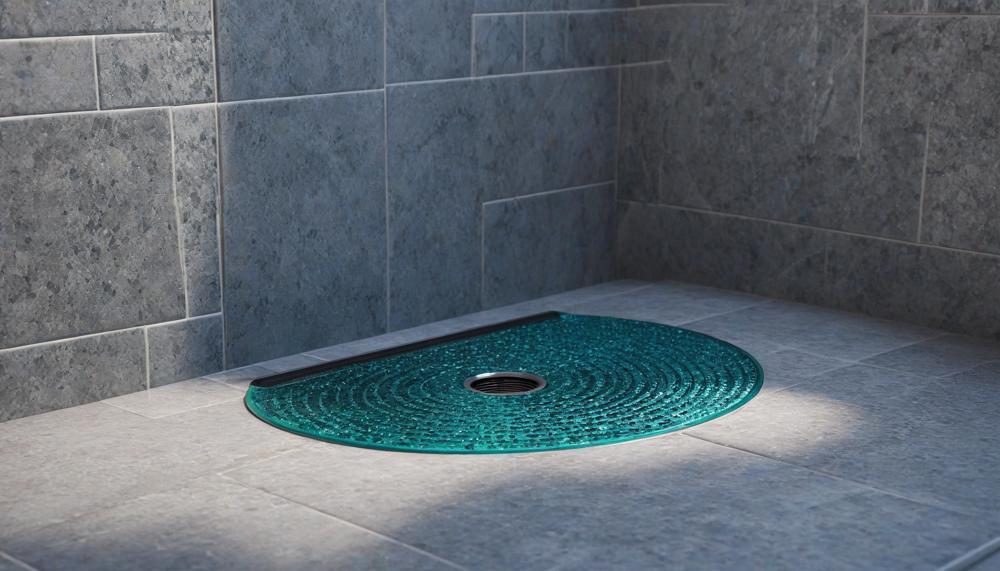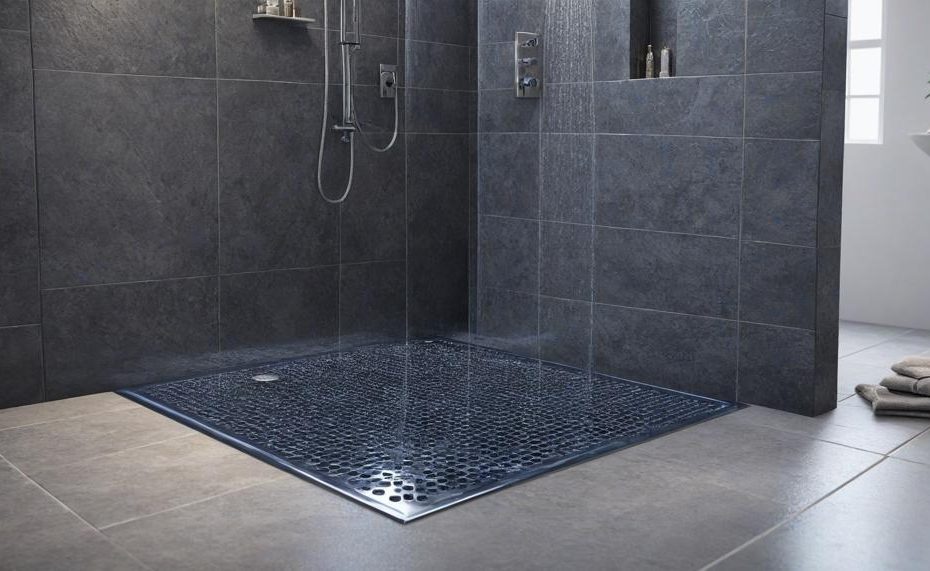When deciding where to place the drain in your shower, the location can significantly influence both its appearance and functionality. Many experts advocate for positioning the drain in the center for ease of installation.
However, this often results in discomfort and frequent clogging. Instead, consider placing the drain approximately 12 inches from the shower head wall, centered side-to-side. This location minimizes standing directly over the drain, enhancing comfort and reducing maintenance.
Additionally, linear drains are an excellent choice, as they direct water away from the standing area. Placing the drain at the side of the shower, a common practice in tub-to-shower conversions, also proves effective. This setup simplifies the installation process and avoids the inconvenience of standing on the drain.
Key Takeaways:
- Avoid the center drain placement to enhance comfort and minimize clogs.
- Position the drain 12 inches from the shower head wall for optimal functionality.
- Consider linear drains to keep water away from the standing area.
- Side drain placements are ideal for easy installation and improved shower experience.
By strategically placing your shower drain, you can ensure a more comfortable, efficient, and aesthetically pleasing showering experience.
Contents
- 1 Shower drain (and drain location) tip #1 – Only buy a ‘standard shower pan’ with a ‘standard drain location’ AFTER you know where your joists are
- 2 Shower drain (and drain location) tip #2 – Don’t assume a center drain is best
- 3 Shower drain (and shower drain) location tip #3 – Consider sayingYesto a ‘Close to the Edge’drain location
- 4 Shower drain (and shower drain) location tip #4 – Keep the drain where it’s at today
- 5 Shower drain (and drain location) tip #5 – Choose a drain (and drain location) which disappears
- 6 Conclusion
Shower drain (and drain location) tip #1 – Only buy a ‘standard shower pan’ with a ‘standard drain location’ AFTER you know where your joists are
Knowing the location of your joists before buying a shower pan with a standard drain location has several advantages. Here’s a detailed breakdown:
| Benefit | Description | Implication |
| Avoid Costly Mistakes | Purchasing a standard shower pan without knowing joist positions can lead to buying a pan with a drain that conflicts with joist locations. | This can necessitate expensive modifications or replacements, saving you from wasted purchases and financial strain. |
| Save Time and Effort | Identifying joist locations ensures that the drain placement on the shower pan aligns with the existing plumbing structure. | This eliminates the need for labor-intensive and sometimes impossible adjustments to joists or plumbing. |
| Use Existing Drain Location | Many standard and custom shower pans allow for the drain to be positioned based on existing setups. | This utilization prevents the need for custom tile pans and reduces installation complexity and cost. |
| Prevent Future Leaks | Choosing a pre-made shower pan with proper drainage minimizes the risk of leaks compared to custom-made tile pans. | This ensures long-term durability and reduces the likelihood of water damage and repairs. |
Shower drain (and drain location) tip #2 – Don’t assume a center drain is best
You should consider other drain locations besides the center for your shower to enhance both the functionality and aesthetics of your shower space.
| Feature | Center Drain | Alternative Locations |
| Comfort | Can be uncomfortable to stand on | Provides a more even surface |
| Clogging | Prone to frequent clogs | Less prone to clogging |
| Design | Standard, less flexible | Sleek, modern designs (e.g., linear drains) |
| Installation | May require extensive plumbing | Efficient, especially for conversions |
| Shower Experience | Water may pool around feet | Better water drainage, cleaner space |
Shower drain (and shower drain) location tip #3 – Consider sayingYesto a ‘Close to the Edge’drain location
Having a shower drain located close to the edge brings a myriad of benefits that enhance both the functionality and aesthetics of your shower. Here’s a detailed look at why this drain placement can be a game-changer for your bathroom design:
| Benefit | Description | Impact |
| Improves Appearance | Locating the drain close to the edge creates a sleek, modern look, especially with a narrow, long rectangular drain. | Gives the shower a cleaner and more elegant appearance, appealing to contemporary design tastes. |
| Enhances Functionality | Prevents standing directly on the drain while showering, typically placed 20″-24″ from the side wall. | Increases comfort during showers, avoiding the annoyance of standing on the drain. |
| Simplifies Installation | Placement near the edge can streamline the installation process, reducing complexity for contractors. | Saves time and potential frustrations during the installation phase. |
| Efficient Drainage | Allows for more efficient drainage, particularly with linear drain systems placed near the side or under the shower head wall. | Minimizes water pooling, reducing the risk of slips and improving safety. |
| Reduces Clogging Issues | By positioning the drain away from the main standing area, it helps prevent clogging issues. | Decreases the likelihood of standing in pools of water when the drain clogs. |
| Design Flexibility | Offers more flexibility in shower design, allowing for creative tile layouts and floor designs. | Enables personalized and unique shower floor designs, enhancing overall bathroom aesthetics. |
| Convenience | Can be placed for convenience near either side or under the shower head wall. | Makes cleaning and maintenance easier and more accessible. |
Shower drain (and shower drain) location tip #4 – Keep the drain where it’s at today
The short answer is: Keeping the shower drain in its current location during a bathroom renovation is essential for several reasons:
| Aspect | Reason | Details |
| Time and Effort | Avoids complex procedures | Relocating involves breaking floors and rerouting plumbing. |
| Cost Efficiency | Saves money | Reduces the need for additional materials and labor costs. |
| Efficient Water Flow | Prevents puddling | Ensures optimal water flow and prevents slippery surfaces. |
| Plumbing Integrity | Avoids blockages | Keeps the plumbing system balanced and reduces clog risks. |
| Convenience | Simplifies renovation | Eliminates the need for complex adjustments and maintains functionality. |
Shower drain (and drain location) tip #5 – Choose a drain (and drain location) which disappears
Choosing a shower drain and drain location that disappears is essential for both aesthetic and functional reasons. Here’s why:
- Enhances Shower Aesthetics: A disappearing drain, such as a linear or hidden drain, blends seamlessly with the shower floor, offering a clean and modern look. This design eliminates visual clutter, creating an elegant, uninterrupted surface that can make the bathroom feel larger and more luxurious.
- Improves Functionality: By placing the drain out of the main standing area, you avoid stepping on it, which can be uncomfortable. It also minimizes the chance of water pooling around your feet if the drain gets momentarily clogged. Positioning the drain strategically, like 12 inches from the shower head wall and centered side to side, ensures optimal drainage and water management, keeping your shower experience comfortable and efficient.
- Simplifies Cleaning and Maintenance: Drains that disappear into the floor are easier to clean since there are fewer visible parts where grime and soap scum can accumulate. With fewer edges and corners, maintaining the drain’s cleanliness becomes a hassle-free task.
- Prevents Water Accumulation: A side or edge drain directs water flow away from the main standing area. This setup is particularly useful in avoiding puddles around your feet during a shower, thus enhancing safety by reducing slip risks.
Comparative Table of Drain Types

| Drain Type | Advantages | Considerations |
| Traditional Center Drain | Common and easy to install Cost-effective |
Visible and can disrupt floor design Water can pool around feet |
| Linear (Side) Drain | Blends with floor design Directs water flow efficiently Reduces water pooling |
More complex installation Higher cost |
| Hidden Drain | Seamless appearance Minimal cleaning required Enhanced aesthetic appeal |
Requires precise installation May need professional help |
Conclusion
Proper placement of a shower drain can significantly impact your shower’s comfort, functionality, and aesthetic appeal. Instead of defaulting to a center drain, consider positioning it approximately 12 inches from the shower head wall, centered side-to-side.
This strategic location minimizes discomfort and reduces maintenance issues associated with standing directly over the drain. Linear drains, which direct water away from the standing area, are an excellent alternative, providing a modern and sleek look while enhancing drainage efficiency.
For those converting a tub to a shower, placing the drain at the side simplifies the installation process and avoids the inconvenience of standing on it. Before purchasing a standard shower pan, ensure you know the location of your joists. This preemptive step helps avoid costly modifications and ensures smooth installation.
In essence, a thoughtfully placed shower drain not only elevates your shower experience by preventing clogs and discomfort but also contributes to a clean, efficient, and visually pleasing bathroom.





